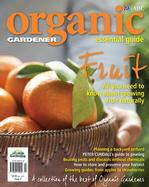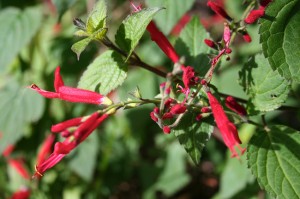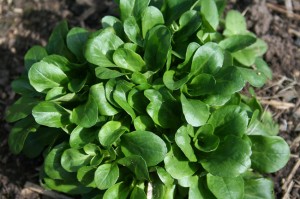At this time of year articles begin to proliferate describing plants you can grow that will lend splashes of colour to sombre autumn and winter days. As usual I am gaining much pleasure from the bright red flowers of pineapple sage (Salvia elegans). So too are the eastern spinebills who flash their tawny throats at me as they fossick for nectar. Also dog’s bane (so named because it’s ability to repel some dogs), Plectranthus ornatus, has been sporting its strong, mauve flowers for months now and will continue to do so right through winter. Really for me the colour highlights in late autumn and winter come from all the plants I haven’t planted, the ones that turn up whether you want them or not.
Read more
The lovely autumn days entice me into the garden where I have been madly weeding and cutting back the prolific summer growth. I love this time of year when the soil is still warm, so plants are still growing, but the intense heat has gone. Two plants that come into their own now are corn salad and landcress. These are both annuals (landcress is sometimes biennial) that self sow around my garden providing salad greens right though autumn and winter.
Corn salad (Valerianella locusta) is also known as lamb’s lettuce, and has a delicate very mild flavour with soft leaves that almost melt in the mouth. The leaves are pale green and rounded and grow in small clumps. You can pick the leaves individually or cut whole plants just above the ground, they will re-shoot. Plants only reach about 30cm in height. There are cultivars with golden, extra large and darker green leaves. Grow corn salad in temperate and cold regions from seed sown in autumn, winter and spring—in hot weather it goes to seed almost immediately. I find that mine goes to seed in spring, then disappears until autumn when the plants appear again in a dense clump. Read more
Coriander, also known as cilantro and Chinese parsley, is one of the most ancient herbs still in use today. It is also claimed by some to be the world’s most widely used herb. Whether this is true or not, coriander leaves and seeds are essential to the cuisine of central and southern America, South-East and northern Asia as well as India and the Middle East.
History
Coriander comes originally from southern Europe where the seeds have been used for centuries, but the leaves were not usually used. Coriander seeds have been found in Egyptian tombs dating from more than 3000 years ago. The Egyptians cultivated coriander in their gardens and offered it at funeral ceremonies. It was used by Hippocrates and other Greek physicians as early as the fifth century B. C., while the Chinese considered that coriander had the ability to bestow immortality. This plant has the distinction of being one of the few herbs mentioned in the Old Testament Num. 11:7
“Now the manna was like coriander seed.”
The botanical and common name, coriander, comes from the Greek word koris which means ‘bug’. This presumably relates to the fact that the smell and flavour of coriander has been unfavourably compared with that of stink bugs. Read more
 Organic Gardener Essential Guide: Fruit
Organic Gardener Essential Guide: Fruit
This mook (a cross between a magazine and a book) is the second in the series produced by Organic Gardener Magazine. It is made up of articles by well-known garden writers from across Australia. Some articles have been previously published by Organic Gardener, others are written specifically for this mook. There is everything from pruning (an article I keep going back to, to check how it should be done) by Peter Cundall to pest control by Jerry Coleby-Williams and planning the orchard by Phil Dudman. It also looks at harvesting and storing the produce. The fruits covered include apples, avocado, bananas, berries, citrus, grapes, mangoes, melons, nuts, olives, passionfruit, stone fruit and strawberries. Comprehensive and cheap at only $10.
Borrow a copy from your library, buy one from your local newsagent or go to the store on this website and buy a copy online
 Organic Gardener’s Essential Guide: Vegies A – Z
Organic Gardener’s Essential Guide: Vegies A – Z
Rising costs have combined with anxiety about food security to create a critical moment for people considering growing their own food. Right on cue is “Vegies A-Z”. It’s the third OG special (after Getting Started, $10.00, and Fruit, $10.00). Vegies A-Z combines new material with recent OG articles from reliable writers. My quibble with this third volume is that there is not more on soil preparation, which is crucial. Perhaps that’s in Getting Started? Perhaps the three volumes need to be read seriatum, and would make a great gift, possibly to yourself. PW is a major contributor. — AMS.
Note: There is more on soil preparation in Getting Started which is unfortunately currently out of print. A reprint is planned for later this year
Borrow a copy from your library, buy one from your local newsagent or go to the store on this website and buy a copy online



